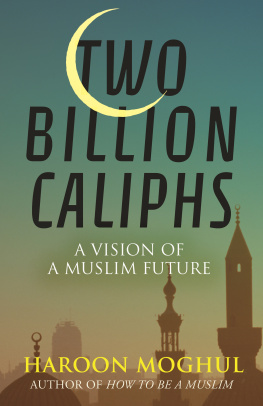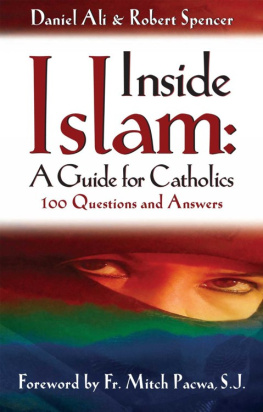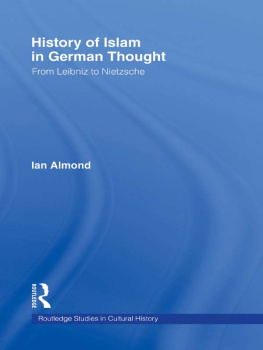Murata Sachiko - Vision of Islam
Here you can read online Murata Sachiko - Vision of Islam full text of the book (entire story) in english for free. Download pdf and epub, get meaning, cover and reviews about this ebook. year: 2011, publisher: Paragon House, genre: Religion. Description of the work, (preface) as well as reviews are available. Best literature library LitArk.com created for fans of good reading and offers a wide selection of genres:
Romance novel
Science fiction
Adventure
Detective
Science
History
Home and family
Prose
Art
Politics
Computer
Non-fiction
Religion
Business
Children
Humor
Choose a favorite category and find really read worthwhile books. Enjoy immersion in the world of imagination, feel the emotions of the characters or learn something new for yourself, make an fascinating discovery.

- Book:Vision of Islam
- Author:
- Publisher:Paragon House
- Genre:
- Year:2011
- Rating:3 / 5
- Favourites:Add to favourites
- Your mark:
- 60
- 1
- 2
- 3
- 4
- 5
Vision of Islam: summary, description and annotation
We offer to read an annotation, description, summary or preface (depends on what the author of the book "Vision of Islam" wrote himself). If you haven't found the necessary information about the book — write in the comments, we will try to find it.
Vision of Islam — read online for free the complete book (whole text) full work
Below is the text of the book, divided by pages. System saving the place of the last page read, allows you to conveniently read the book "Vision of Islam" online for free, without having to search again every time where you left off. Put a bookmark, and you can go to the page where you finished reading at any time.
Font size:
Interval:
Bookmark:
THE
VISION OF
ISLAM
by
Sachiko Murata
and
William C. Chittick
 PARAGON HOUSESt. Paul, Minnesota
PARAGON HOUSESt. Paul, Minnesota VISIONS OF REALITY
A Series on Religions as Worldviews
Series Editor: Roger Corless, Duke University
Editorial Board: R. Ninian Smart, University of California, Santa Barbara
Charles H. Long, University of California, Santa Barbara
A common assumption behind many surveys of religions is that there is something called religion which is a uniquely classifiable phenomenon and which may be dealt with and written about according to recognized and agreed upon subdivisions. Systems identified as religions are then fitted into a prescribed format without considering whether the format is suited to the particular system under consideration.
This series is motivated by the awareness that, rather than there being something called religion, there are many religions, and the more they are studied, the more each one manifests itself as equally profound, nontrivial, and adequate unto itself. Each volume will be an attempt to take each religion on its own terms. Comparison may be made with other religious traditions, but there will be no attempt to impose a single methodology in order to reduce the plurality of one basic scheme.
Published Volumes in the Visions of Reality Series:
THE VISION OF BUDDHISM
Roger Corless
THE VISION OF ISLAM
Sachiko Murata and William Chittick
Envisioned subsequent volumes on specific religions
or families of religions:
The Vision of China
The Vision of Christianity
The Visions of the Elders: An Anthology
The Vision of Hinduism
The Vision of Japan
The Vision of Judaism
The Vision of the West
and
Visions of Reality: Understanding Religions Understanding Themselves
(a methodological volume)
Published in the United States by
Paragon House
1925 Oakcrest Avenue, Suite 7, St. Paul, MN 55113-2619
Phone: 651-644-3087 / Fax: 651-644-0997
www.paragonhouse.com
Copyright 1994 by Paragon House
All rights reserved. No part of this book may be
reproduced, in any form, without written permission from
the publishers, unless by a reviewer who wishes
to quote brief passages.
ebook ISBN: 978-1-61083-042-3
Library of Congress Cataloging-in-Publication Data
Murata, Sachiko, 1943
Vision of Islam : reflecting on the Hadith of Gabriel / by Sachiko Murata and William Chittick 1st ed.p. cm. -- (Visions of reality. Understanding religions)Includes bibliographical references and index.ISBN 1-55778-516-3 (pbk.)1. Islam. I. Chittick, William C. II. Title. III. Series.BP161.2.M78 1994297--dc20 94-16064CIP
Contents

Preface
T his book grew out of an introductory course on Islam that one or the other of us has taught at least once a year since 1983 in the Program in Religious Studies at the State University of New York, Stony Brook. In teaching this course, we have dedicated our efforts to understanding the vision that animates the Islamic texts and to expressing it in the language of a Long Island classroom. From the beginning, we have been faced with the problem of presenting Islam to many kinds of students. Most of them come from Long Island or the New York City area, and they represent an extremely diverse cross section of Americans and other nationalities. Typically, about one-third are first or second generation immigrants from the Islamic world, ranging from China and Indonesia to Albania and Morocco.
The majority of non-Muslim students take a course on Islam because they need to fulfill a distribution requirement or because the hour was convenient. Muslim students attend for a variety of reasons. Some are quite distant from Islam but have developed enough disquiet about American society to have begun the search for their roots. Others have parents or grandparents who have insisted that they must learn something about their religion. Still others feel that, since they are Muslims, this course will provide them with an easy A (these students experience a rude awakening). Occasionally, an adherent of one of the political ideologies that are collectively referred to as fundamentalism attends the class in order to see for himself why non-Muslim scholars cannot be trusted in their evaluations of Islam.
This diverse audience has accentuated the problem of how to present Islam without distorting it. How is it possible to explain Islam both to Muslims, whoas a general rule know nothing about their own religion but are defensive, and to Westerners, who also know nothing but are instinctively hostile? One way, which we always employ, is to have the students read various sympathetic accounts by contemporary scholars; fortunately the number of these is increasing.1 Another way is to approach Islam not as an alien, third-world, outdated enterprise, but as one of the several, currently living world views that give meaning to the lives of billions of people. From the beginning, the basic goal of our lectures has been to provide Islamic self-understanding, and our lecture notes make up the substance of this book.
Many works on Islam acknowledge Islams living relevance in the contemporary world, but few take notice of what the universe looks like through Muslim eyes. Or, if Muslim views are cited, they usually belong to those who have taken a political stance with full awareness of the importance of the modern media. Such people have replaced serious and leisurely discussion of the nature of things the traditional approach in centers of learning in the Islamic worldwith dramatic declarations and camera-wise media events.
The few studies of Islam that attempt to reveal the depth of Islamic thinking demand too much knowledge of the religion for beginning students and are usually couched in language that is primarily a derivative of the Western tradition. Even if an attempt is made to rely on Koranic terminology, seldom is much attention paid to the richness and diversity of Islams own intellectual tradition.
Our approach in this book is focused on bringing out what Islam has thought of itself. By Islam, we mean the great texts that have been universally acknowledged (until recent times) as the highpoints of the tradition. Like any great religion, Islam has its towering landmarks, and it is from these that we have sought to understand it. Such texts are rooted in the Koran. In a very deep sense, Islam is the Koran, and the Koran is Islam. The basic interpretation of the Koran is provided by Muhammad himself. Following in his wake, numerous great figures sages, saints, philosophers, theologians, juristshave elucidated and interpreted the nature of the original vision in keeping with the needs of their times.
In this book we try to pry open the door to the Islamic universe. We are not interested in evaluating Islam from within those dominant perspectives of modern scholarship that make various contemporary modes of self-understanding the basis for judging the subject. Instead, we want to portray Islam from the perspective of those great Muslims of the past who established the major modes of Koranic interpretation and Islamic understanding.
This is not to say that we will simply translate passages from the classical texts in the manner of an anthology. The classical texts ask too much from beginning readers. They were not written for people coming from another cultural milieu. Rather, they were written for people who thought more or less the same way the authors did and who shared the same world view. Moreover, as a general rule they were written for those with advanced intellectual training, a type of training that is seldom offered in our graduate schools, much less on the undergraduate level.
Next pageFont size:
Interval:
Bookmark:
Similar books «Vision of Islam»
Look at similar books to Vision of Islam. We have selected literature similar in name and meaning in the hope of providing readers with more options to find new, interesting, not yet read works.
Discussion, reviews of the book Vision of Islam and just readers' own opinions. Leave your comments, write what you think about the work, its meaning or the main characters. Specify what exactly you liked and what you didn't like, and why you think so.










